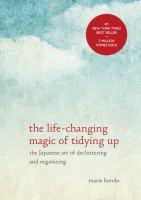
I cannot figure out why this book is such an overwhelming success. I am very torn in my opinion of Marie Condo’s “konmari” method to declutter one’s life, finding some of the teachings notable, but overall unnecessarily extreme and impractically harsh. The main theme of the book is to simplify by ridding oneself of everything that does not “spark joy.” By going through possessions item by item, the konmari method will strip away all unused, superfluous and sentimental items that serve no immediate, direct purpose. Taking to heart the books methodology, I’d like to systematically go through some of what I feel are the stronger and weaker elements of the book.
Let’s start with a good point. One take away I got from this book is the importance of folding your clothes in a way that makes them visible—all of them! Like we organize our books and movies so the spines face out for easy identification and accessibility, folding and storing your clothes so they are all visible makes it so you not only remember what you have, but it makes them easier to get to when wanted. I do not agree, however, with Condo’s clothes ideology that no one should own “lounge clothes.” Condo argues we should never wear lounge clothes because they put us in a slovenly frame of mind and give others a negative impression of us. I think this is ridiculous. There is nothing that sparks more joy in me then getting home and putting on sweat pants, and I find it bonds me and my husband more because we are able to relax together in this state.
Another konmari teaching I found compelling, and probably controversial to support as a librarian, is Condo’s belief that we shouldn’t keep books just to keep them. Read them and get rid of them--by donating them to the library, of course! If you haven’t read a book yet, genuinely assess whether you’re going to read it, and then either do so or get rid of it. I’d like to extrapolate on this by arguing that even most non-fiction books that may be useful at some point (i.e. cookbooks, guidebooks, etc.) are unnecessary because the information is accessible online, and frankly, easier and faster find. The same goes for instruction manuals, bank statements and medical records. Sentimental cards and letters, however, continue to serve a purpose in my opinion, even if stashed in a shoebox under a bed. Condo says these have served their purpose and should be discarded, but knowing they are there sparks great joy and love in me, and though they serve no practical use, I could not part with mine.
I almost stopped reading this book all together a quarter of the way in when Condo posed that we shouldn’t hand down our unwanted or no longer used items to friends and family. She thinks these items are more often burdensome to the receiver than helpful and that if you don’t want to throw away your old stuff, then you should donate it to an anonymous party. Given that half the items in my house are hand-me-downs, I could not disagree with this sentiment more. I am so appreciative of the items I have received from people I know when they’ve upgraded their own possessions, and likewise, I have gotten a lot of pleasure from passing along my old possessions to others who could use them. I understand her point that we shouldn’t just give everything we no longer want to our friends and family, but making the blanket statement that we shouldn’t give any used items to people we know seems exceptionally narrow minded to me.
I could continue to ramble on about my opinion of the pros and cons of this book, but in the end, each reader will have to assess the points that apply to them and the ones that don’t. It’s a short book, so if you’re looking for help cleaning up your disorganized or overstuffed life, try picking up this book and maybe you’ll glean some useful tips. There’s irony in this book needing sifting through to separate the useful verse the excessive. And once done reading, make sure to then pass the book along; even this book is just another piece of unneeded clutter.
